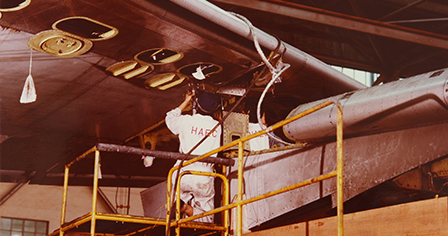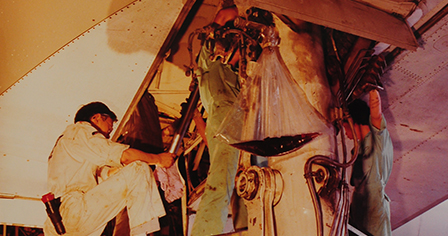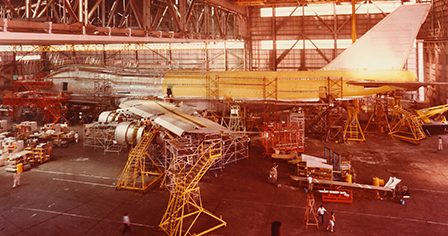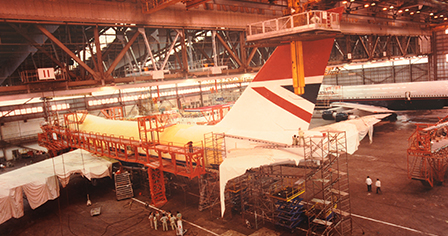
 Stories
Stories
-
14
Why I joined HAECO
-
15
The apprentices
-
16
MET flyer
-
17
CV240
-
18
Mistakes & even more mistakes
-
19
Up in the air
-
20
When boss calls
-
21
Craftsmanship rules
-
22
Package matters
-
23
Seaplanes maintenance
-
24
Reconfiguration
-
25
Fixing the gas tank
-
26
Tempting staff benefits
-
27
New business
-
28
747 inauguration
-
29
New is not enough
-
30
We rock the world
-
31
Lufthansa incident
25


Lau Tat Chiu
I bet you’re all interested in this question. Which rule do you think we had to follow every time we crawled into the fuel tank for maintenance?
1.Pray to master Lu Ban
2.Take off our rings
3.Take off our shoes
4.Put on a red jacket
2.Take off our rings
3.Take off our shoes
4.Put on a red jacket

Mrs. Wong
Take off the rings?

Kelvin
Put on the red jacket?

Lau Tat Chiu
Well, it was to take off our shoes!
gas tank
The fuel tank of Cathay Pacific’s “TriStar” consisted of a kind of aluminium that was vulnerable to bacterial corrosion. So every time it came back for service we had to get into the fuel tank to wrap the fuel quantity transmitter with a chemical that eliminates the bacteria. We were too impetuous at that time to have crawled into the tank immediately after the plane arrived — people nowadays let it outgas for several hours, measure the volatility and wear a mask — that a colleague of mine fainted inside the tank and we spent a great deal of effort to pull him out. So after that we set up a rule: whenever one crawled into the tank, he had to leave his shoes on the ladder outside so that we knew someone was there. It’s better to have a companion waiting outside because we didn’t have time to let the oil volatilized. The fuel tank was under the wing, and we crawled in by drilling a hole.
Apart from leaving the shoes, the practice shown in the photo was another effective “aboriginal” way of working: the loosened screws were put inside a pouch hanged nearby (notice the many pouches hanged down from different parts of the wing), so workers would not misplace or mix up the screws loosened from different parts.
The fuel tanks were found inside the aircraft belly and wings. Workers had to crawl into the tank through the wheeled undercarriage.

Lau Tat Chiu
Now, an even more interesting question: what gift did we receive every time after we finished with the fuel tank maintenance?
1. A cup of coffee
2. A bottle of milk
3. A can of coke
4. A bottle of miniature liquor
1. A cup of coffee
2. A bottle of milk
3. A can of coke
4. A bottle of miniature liquor

Mrs. Wong
Coke! Both HAECO and Coca-Cola belong to Taikoo!

Jenny
Well, miniature liquor is more precious!

Lau Tat Chiu
The answer is, a bottle of milk!
gas tank
Whenever we worked in the fuel tank for more than two hours, we got a bottle of milk and a subsidy of $2. I heard it was good for us to have some milk. $2 was very attractive at that time. Our hourly rate was only $12.5.

Huen Shing
I got inside once. There was an opening at the undercarriage for us to go out. It was a C-47.
gas tank
It stank very badly. At that time, 707 used gasoline instead of today’s kerosene. Sure we would pass out without an air blower. Only one person could get in, and we didn’t have any special equipment. Those who did the spraying and the repairing would have the milk. Mostly they didn’t drink it because they may get diarrhea. No one liked to drink it.

Law Tak Shing
There must be milk whenever they went in, because the gasoline odour stayed in the throat.

Lee Ping
gas tank
There was a group specialized in fuel tank maintenance. On one occasion I got into the fuel tank of a 880, and the gasoline really burnt my eyes. It was very painful. I couldn’t stand it. Then my boss, a foreigner (外老), tried to go in by himself and he got out with a pair of blood-red eyes. There was the smell of stale kerosene. I remembered someone passed out inside the fuel tank and he had to be dragged out. The spraying workers and those having worked inside were given a bottle of milk to drink. On the bottle was written “reconstituted milk”.












